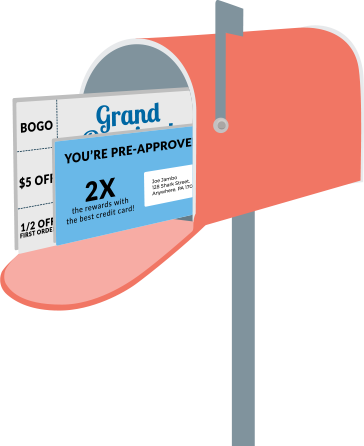 Type “What is direct mail marketing?” into a search engine, and you’ll get all kinds of results. They range from brief definitions of direct mail to tips on design and choosing the right mailing list. In this article, we’ll take an in-depth look at direct mail marketing. This includes what it is, who uses it, what types of direct mail there are, how it ends up in the mailbox, and what factors determine the cost. Our goal is to give you a solid understanding of what direct mail marketing is and how it works.
Type “What is direct mail marketing?” into a search engine, and you’ll get all kinds of results. They range from brief definitions of direct mail to tips on design and choosing the right mailing list. In this article, we’ll take an in-depth look at direct mail marketing. This includes what it is, who uses it, what types of direct mail there are, how it ends up in the mailbox, and what factors determine the cost. Our goal is to give you a solid understanding of what direct mail marketing is and how it works.
Let’s get started.
Definitions
What is direct mail marketing? Direct mail marketing is the making and sending of advertising materials through the mail. It includes audience research, list building, and more.
What is direct mail? Direct mail is advertising mail not requested by the recipient. Direct mail comes in a variety of formats and usually includes an offer.
Who Uses Direct Mail Marketing?
Businesses and organizations from a variety of industries use direct mail marketing. Restaurants, grocery stores, and auto repair shops send menus, coupons and promotions. Politicians, charities, and nonprofit groups send donation letters, brochures, and campaign postcards. Even tech companies use direct mail marketing to reach their prospects. Any business that sells a product or service is a good candidate for a direct mail campaign.
Does Direct Mail Work?
It does! The upward trend in response rates over the years shows direct mail’s effectiveness. According to the 2018 DMA Response Rate Report, direct mail got an impressive 9% (house lists) and 5% (prospect lists). Direct mail response rates are higher than all forms of digital advertising – combined. You can learn more about how awesome direct mail is in our Is Direct Mail Dead? article and infographic.
How to Send Direct Mail
There are two main ways to send direct mail: shared mail and standalone mail. Shared mail is when advertisers share space with other businesses in the same mail piece. Standalone mail is when advertising is its own mail piece.
Shared Mail
Shared mail (aka marriage mail) is direct mail marketing where advertisers share space. Predefined mailing areas make a separate mailing list unnecessary. The advertisers split the cost of postage. Both of these make shared mail very cost-efficient, sometimes as low as a few cents per household.
Examples of shared mail include Valpak, RedPlum, and Clipper Magazine.
There are several size and placement options available for your ads in a shared mail piece. You could choose a full-page ad in a circular, or a flyer in an envelope with other offers.
Pros
- Low cost
- Broad reach since they’re distributed to everyone in a particular area
Cons
- Your ad is with dozens of other ads
- You’re likely to appear alongside your direct competitors
- No personalization options
- Lower response rates
- Sent to predefined mailing areas on set schedules
- No targeting options
Standalone Mail
Standalone mail is anything not grouped with other advertisements. Standalone costs more than shared mail because you’re paying for everything. Most of the time, standalone mail requires you to provide or buy your mailing list.
Standalone mail is how you send direct mail postcards. You can also use it to send self-mailers and envelope mailers. There are endless possibilities for the format and presentation of standalone direct mail. As long as you meet certain USPS size requirements, the only limit to how creative you can be is your budget. Mail Shark sends standalone mail only.
Pros
- One-on-one communication with the recipient
- Countless format and presentation options
- Target audiences based on demographics, geography, psychographics, etc.
- Personalize for each recipient
- Higher response rates
- Can have broad reach or target a specific audience
Cons
- More expensive than shared mail
Types of Direct Mail
There are six types of direct mail (also called mail pieces, products, formats, or mailers). But what are mailers? A mailer is any piece of direct mail, no matter what shape or size it is. Below are some of the most common direct mail formats and some popular use cases.
Direct Mail Postcards
Postcards are a low cost option and the most common form of direct mail. You can choose from a few sizes.
Best For:
- Appointment reminders
- Thank you cards
- Prospecting
- Promotions
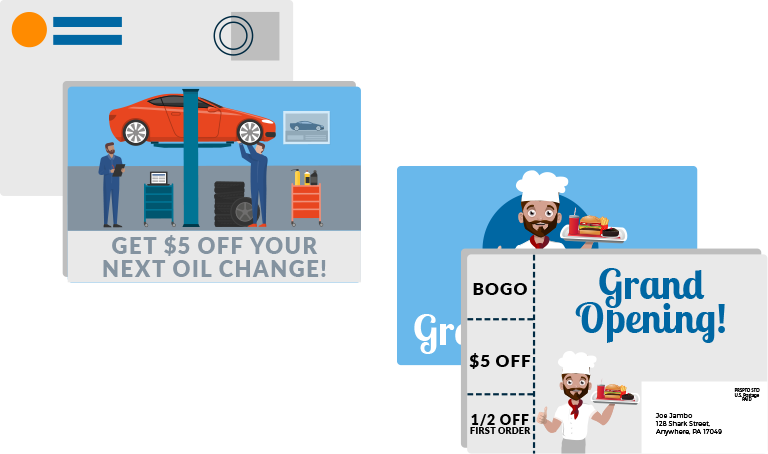
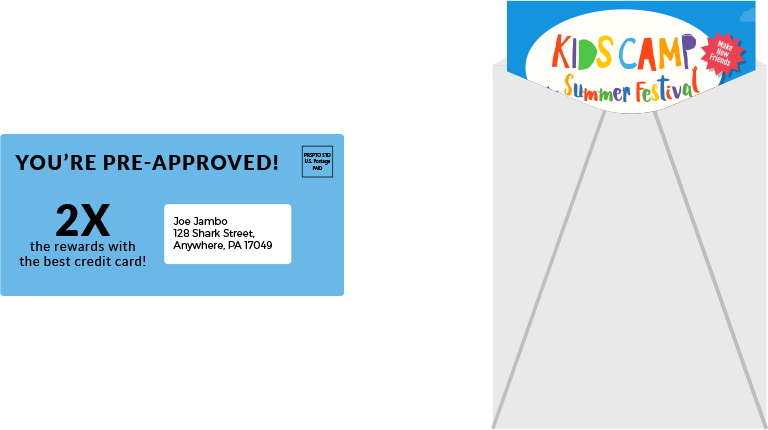
Direct Mail Letters
Envelopes help protect the contents of your letters from prying eyes. Because there is more than one piece, they cost more than postcards or folded self-mailers. There are various options for envelope color, size, and material.
Best For:
- Confidential mail
- Mail with more than one component (letter, brochure, order forms, etc.)
Self-Mailers
Self-mailers (brochures, menus, etc.) don’t need an envelope, so they’re a low-cost option. They’re made from a single folded sheet of paper or card stock and are sometimes tabbed or glued to keep closed.
Best For:
- Explaining products and services in depth
- Offering lots of coupons


Catalogs and Booklets
Catalogs and booklets are multi-page mail pieces with a bound edge. They’re available in a variety of sizes and are almost never sent in an envelope.
Best For:
- Showcasing a lot of products and marketing content
- Informational packets
Circulars, Inserts, and Wraps
Circulars, inserts, and wraps are an efficient and cost-effective marketing format. They’re printed on lightweight paper. Inserts and wraps appear inside or around larger pieces like newspapers.
Best For:
- Distributing print coupons
- Product and sales advertisements
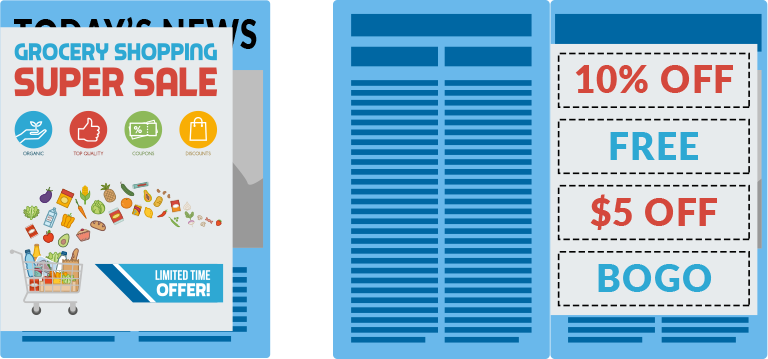
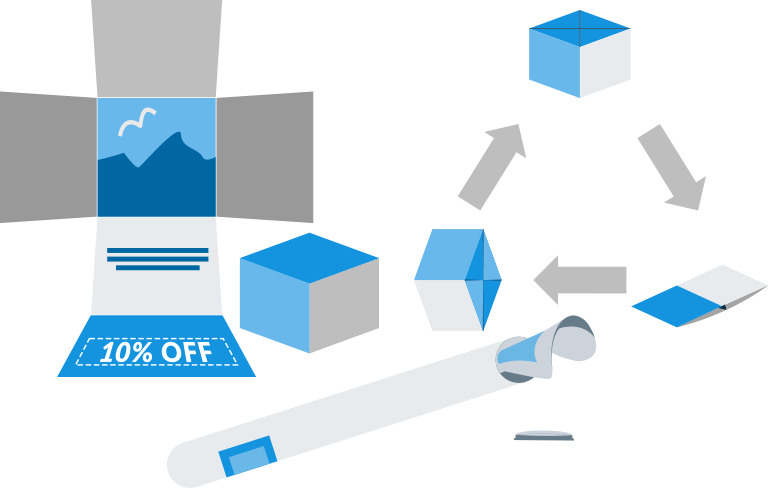
Parcels and Dimensional Mailers
Parcels and dimensional mailers aren’t flat like postcards or letters. Their design and size help you grab your prospects’ attention, but they can be costly.
Best For:
- Mailing to a small group of high-value prospects
Direct Mail Mailing Lists
Now you know what direct mail is and what it looks like, but how does it end up in people’s mailboxes? Shared mail is self-explanatory. No mailing list required. Choose from your provider’s available, pre-defined mailing areas.
For standalone mail you need to decide who to mail to, and then get a mailing list. We’ll go over the two main types of mailing lists below.
Once you’ve decided who to mail to, you’ll have a better idea of the delivery options available to you. While you can send direct mail through FedEx or UPS, most goes through the USPS. But you might use FedEx or UPS if you’re overnighting a parcel or dimensional mailer.
Mailing List Types
You’ll need to decide who you want to reach before sending your campaigns. We’ve included the USPS delivery options available based on the mailing list type below.
Saturation Mailing Lists
If you want to reach most of the people in a single geographic area, choose a saturation mailing list. With this type of mailing list you’ll mail to entire ZIP codes or carrier routes. Saturation mailing lists have few targeting options, so the cost is low. Saturation mailings should be in walk sequence and meet the 90/75 rule, which helps keep the costs low. You can rent a saturation mailing list from a broker or list provider.
Benefits of Saturation Mailing Lists
- Allows for the lowest postage rates
- Ideal for businesses that offer goods and services most people need
- Use median demographics for carrier routes for your mailing
- Perfect for drawing large crowds and announcing events, new locations, or products
USPS Delivery Options for Saturation Mailing
- Marketing Mail (Standard Mail)
- Every Door Direct Mail® (EDDM®)
Targeted Mailing Lists
If you want to reach specific demographics, choose a targeted mailing list. These lists can be filtered by geographic, demographic, and psychographic selects, among others. Because a targeted list uses selects to find the right audience, it costs more than a saturation list. You can rent a targeted mailing list from a broker or list provider. You can also build and maintain your own house mailing list.
Benefits of Targeted Mailing Lists
- Ability to segment your list by almost any criteria imaginable
- Reaches a more specific, qualified audience
- Better potential response rates than using a saturation list for the same marketing
USPS Delivery Options for Targeted Mailing
- First-Class
- Priority Mail
- Marketing Mail (Standard Mail)
Direct Mail Costs
Are you wondering how much direct mail costs? As you can see, there are a lot of factors that go into direct mail marketing that can influence the price you pay. Here’s a quick overview of the main costs of direct mail marketing:
- Mailing List: Saturation lists cost the least. If you need a very specific audience, you’ll want to choose a targeted list. The more selects or filters you add to a targeted list, the more expensive it gets.
- Design: The price you pay for your design can vary depending on a variety of factors. If you create your own design in-house, you could save some money. Having someone else do your design often comes with a fee, but some providers include it for free.
- Printing: Print costs vary based on the quantity and complexity of what you’re printing. The smaller and simpler the format, the lower the cost to print your pieces. Adding variable data printing (VDP) and high-end materials or finishes increases your printing costs.
- Postage: Several factors determine your final postage rate. Marketing Mail and EDDM® bulk postage rates are lower than First-Class and Priority mail. Your format and mailing list type will determine which of these are options.
Lower Your Postage Costs with Discounts
One way to lower your costs is through postage discounts. The discounts you can get depend on how much prep work you do for the post office. Whenever you save the post office time or money, you get a postage discount. Actions you can take to receive postage discounts include:
- Presorting, or grouping, your mail together by ZIP code
- Standardizing and verifying deliverable addresses using CASS (Coding Accuracy Support System) certification software
- Running your list through the National Change of Address (NCOA) database
- Formatting your mail pieces to meet USPS machinability standards
- Including an Intelligent Mail Barcode (IMB) to meet USPS automation requirements
Mail Shark can provide these services for you to make sure you get the lowest possible postage rates.
What’s Next?
You’re well on your way to understanding direct mail marketing. If you’d like to learn more about direct mail, check out these other resources:
- 4 Keys to Direct Mail Success
- How to Get a Direct Mail Mailing List
- How to Write Direct Mail Copy That Sells
- How to Design a Direct Mail Piece
Or, if you’d like to discuss direct mail with one of our experts, give us a call or fill out the contact form. We’ll walk you through how direct mail can benefit your business.
